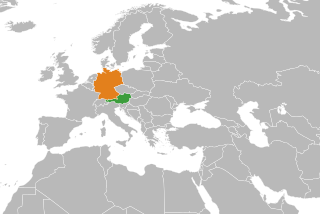The history of Austria covers the history of Austria and its predecessor states. In the late Iron Age Austria was occupied by people of the Hallstatt Celtic culture, they first organized as a Celtic kingdom referred to by the Romans as Noricum, dating from c. 800 to 400 BC. At the end of the 1st century BC, the lands south of the Danube became part of the Roman Empire. In the Migration Period, the 6th century, the Bavarii, a Germanic people, occupied these lands until it fell to the Frankish Empire established by the Germanic Franks in the 9th century. The name Ostarrîchi (Austria) has been in use since 996 AD when it was a margravate of the Duchy of Bavaria and from 1156 an independent duchy of the Holy Roman Empire (962–1806).

The Austrian Armed Forces are the combined military forces of Austria.

The Austrian Empire, officially known as the Empire of Austria, was a multinational European great power from 1804 to 1867, created by proclamation out of the realms of the Habsburgs. During its existence, it was the third most populous monarchy in Europe after the Russian Empire and the United Kingdom, while geographically, it was the third-largest empire in Europe after the Russian Empire and the First French Empire.
Following the termination of hostilities in World War II, the Allies were in control of the defeated Axis countries. Anticipating the defeat of Germany, Italy and Japan, they had already set up the European Advisory Commission and a proposed Far Eastern Advisory Commission to make recommendations for the post-war period. Accordingly, they managed their control of the defeated countries through Allied Commissions, often referred to as Allied Control Commissions (ACC), consisting of representatives of the major Allies.

The Austrian State Treaty or Austrian Independence Treaty established Austria as a sovereign state. It was signed on 15 May 1955 in Vienna, at the Schloss Belvedere among the Allied occupying powers and the Austrian government. The neighbouring Federal People's Republic of Yugoslavia acceded to the treaty subsequently. It officially came into force on 27 July 1955.

Klosterneuburg, frequently abbreviated to Kloburg by locals, is a town in the Tulln District of the Austrian state of Lower Austria. It has a population of about 27,500. The Stift Klosterneuburg, which was established in 1114 and soon after given to the Augustinians, is of particular historical importance.

First Vienna FC is an Austrian football club based in the Döbling district of Vienna. Established on 22 August 1894, it is the country's oldest team and has played a notable role in the history of the game there. It is familiarly known to Austrians by the English name Vienna.

Laa an der Thaya is a town in the Mistelbach District of Lower Austria in Austria, near the Czech border. The population in 2016 was 6,224.

The Austrian Air Force is a component part of the Austrian Armed Forces.
The formation of the European Advisory Commission (EAC) was agreed on at the Moscow Conference on 30 October 1943 between the foreign ministers of the United Kingdom, Anthony Eden, the United States, Cordell Hull, and the Soviet Union, Vyacheslav Molotov, and confirmed at the Tehran Conference in November. In anticipation of the defeat of Nazi Germany and its allies this commission was to study the postwar political problems in Europe and make recommendation to the three governments, including the surrender of the European enemy states and the machinery of its fulfillment. After the EAC completed its task it was dissolved at the Potsdam Conference in August 1945.

Austria was occupied by the Allies and declared independent from Nazi Germany on 27 April 1945, as a result of the Vienna offensive. The occupation ended when the Austrian State Treaty came into force on 27 July 1955.

Relations between Austria and Germany are close due to their shared history and culture, with German being the official language and Germans being the major ethnic group of both countries.

Lokomotivfabrik Floridsdorf was an Austrian locomotive works founded on 6 September 1869 that achieved a pre-eminent place amongst European locomotive builders thanks to the quality and diversity of its designs.

Foreign relations exist between Austria and France. Both countries have had diplomatic relations with each other since the Middle Ages. Both countries are full members of the Council of Europe and the European Union.

Foreign relations exist between Austria and Serbia and their predecessor states. Austria has an embassy in Belgrade. Serbia has an embassy in Vienna and a general consulate in Salzburg. Austria is a European Union member and Serbia is a European Union candidate.

Austria, formally the Republic of Austria, is a landlocked country in Central Europe, lying in the Eastern Alps. It is a federation of nine states, one of which is the capital, Vienna, the most populous city and state. Austria is bordered by Germany to the northwest, the Czech Republic to the north, Slovakia to the northeast, Hungary to the east, Slovenia and Italy to the south, and Switzerland and Liechtenstein to the west. The landlocked country occupies an area of 83,879 km2 (32,386 sq mi) and has a population of around 9 million.

Gustav von Myrdacz was an Austrian noble who was instrumental in organizing the Royal Albanian Army from the early 1920s to 1945. He was referred to in Albania as Gustav Mirdashi.

Austria–Soviet Union relations were established in 1924, discontinued in 1938 following German annexation of Austria and renewed following Austrian independence after World War II.














